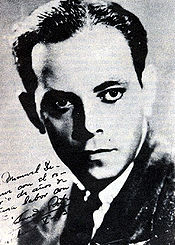
Amadeo Roldán
Encyclopedia

Cuba
The Republic of Cuba is an island nation in the Caribbean. The nation of Cuba consists of the main island of Cuba, the Isla de la Juventud, and several archipelagos. Havana is the largest city in Cuba and the country's capital. Santiago de Cuba is the second largest city...
n composer
Composer
A composer is a person who creates music, either by musical notation or oral tradition, for interpretation and performance, or through direct manipulation of sonic material through electronic media...
and violin
Violin
The violin is a string instrument, usually with four strings tuned in perfect fifths. It is the smallest, highest-pitched member of the violin family of string instruments, which includes the viola and cello....
ist. Roldán was born in Paris to a Cuban mulatta and a Spanish father. It was his mother, the pianist Albertina Gardes, who initiated her children to music (his sister María Teresa was a mezzo-soprano and his brother Alberto a cellist).
Roldán came to Cuba in 1919 after studying music theory and violin at the Madrid Conservatory
Madrid Conservatory
-History:The Royal Conservatory of Music was founded on July 15, 1830, by royal decree, and was originally located in Mostenses Square, Madrid. In 1852 it was moved to the Royal Opera, where it remained until the building was condemned by royal order and classes ordered to halt in 1925. For the...
, graduating in 1916. He became the concert-master (first-chair violin) of the new Orquesta Sinfonica de La Habana in 1922. In the mid-1920s he was appointed concert-master of the Orquesta Filarmonica of Havana (he would assume the position of conductor in 1932) and founded the Havana String Quartet.
During this period, Roldán, one of the leaders of the Afrocubanismo
Afrocubanismo
Afrocubanismo: the movement in black-themed Cuban culture with origins in the 1920s, as in works by the cultural anthropologist Fernando Ortiz. The movement marks the time, between the two world wars, when white intellectuals in Cuba acknowledged openly the significance of African culture in Cuba....
movement, wrote the first symphonic pieces to incorporate Afro-Cuban percussion instruments. The fifth and sixth of his Rítmicas (1930) appear to be the first works in the Western classical music tradition scored for percussion alone. Roldán's best known composition is the 1928 ballet La Rebambaramba, described by a critic of the era as "a multicolored musicorama...depicting an Afro-Cuban fiesta in a gorgeous display of Caribbean melorhythms, with the participation of a multifarious fauna of native percussion effects, including a polydental glissando on the jawbone of an ass."
Roldán's compositions included Overture on Cuban themes (1925), Three little poems: (Oriente, Pregón, Fiesta negra: 1926), and two ballets: La Rebambaramba (a ballet colonial in two parts: 1928) and El milagro de Anaquille (1929). There followed a series of Ritmicas and Poema negra (1930) and Tres toques (march, rites, dance) (1931). In Motivos de son (1934) he wrote eight pieces for voice and instruments based on the poet Nicolas Guillen
Nicolás Guillén
Nicolás Cristóbal Guillén Batista was a Cuban poet, journalist, political activist, and writer. He is best remembered as the national poet of Cuba.Guillén was born in Camagüey, Cuba...
's set of poems with the same title. His last composition was two Piezas infantiles for piano (1937). His work was regularly featured in concerts sponsored by the Pan-American Association of Composers, founded by Henry Cowell
Henry Cowell
Henry Cowell was an American composer, music theorist, pianist, teacher, publisher, and impresario. His contribution to the world of music was summed up by Virgil Thomson, writing in the early 1950s:...
, including the inaugural, March 1929 performance in New York
New York
New York is a state in the Northeastern region of the United States. It is the nation's third most populous state. New York is bordered by New Jersey and Pennsylvania to the south, and by Connecticut, Massachusetts and Vermont to the east...
.
Roldán died at the peak of his creative powers at 38, of a disfiguring facial cancer (he had been an inveterate smoker). His career followed a similar path to Alejandro García Caturla
Alejandro García Caturla
Alejandro García Caturla was a Cuban composer of art music and creolized Cuban themes.He was born in Remedios. At sixteen he became a second violin of the new Orquesta Sinfonica de La Habana in 1922, where Amadeo Roldán was concert-master . He also began composing at a young age, whilst studying...
, and the two men are considered to be pioneers of modern Cuban symphonic art.

